|
ANDREW J. HARRIS -
TAMPA'S FIRST FIRE CHIEF OF A PROFESSIONAL FIRE DEPARTMENT
A. J. Harris's lifetime events described here come from two
Tampa newspaper articles; one published at the time
of his death, and one a year later. Merged into the story is
info from newspaper
articles in the Savannah Daily Morning News before he came to Tampa
and some after he came to Tampa. Also included is info
gathered from articles in Tampa newspapers, along with various other records such as censuses.
A. J.
Harris was born on Aug. 28, 1838 in Gibraltar, England* (the place
of the famous landmark Rock of Gibraltar) and came to the
States with his stepfather when he was a boy of 16*. Although
Gibraltar is located at the Atlantic's
entry into the Mediterranean Sea, on the southern tip of Spain, it
was and still is owned by England.
[*Harris's birth date & place is from a
Tampa
Tribune article published the day after his death. Month
and year are in agreement with Harris's 1900 Census in Tampa.
A year after his death, the
Tribune
published a tribute to Harris using a narrative from a letter
they say was received by his widow and daughter from an "unknown
friend." That letter claims he was born Aug. 28, 1839 in
Liverpool, Eng. Harris may have left England from the port of
Liverpool and so it may be that this "unknown friend" thought he was
born there. Harris's 1900 census
in Tampa shows he immigrated in 1850 and had lived in the U.S. for
50 years. If correct, he would have been 11 or 12 at the time he
came.]
While a young man in
Philadelphia, Harris first acquired his
passionate love for service as a fireman, and never relinquished it
for a moment his entire life. He served as a volunteer
substitute in the Philadelphia fire department along with
George T. Chamberlain. From there he worked his way up to the
head of a department.
[Chamberlain was a successful
businessman and real estate developer of Tampa. He served in
Tampa city government as councilman and on various committees
including the fire department.].
A. J. HARRIS IN SAVANNAH, GEORGIA
From Philadelphia Harris
moved to Savannah, Georgia and enlisted in the Confederate army
during the Civil War. Afterwards he became a leading member of a highly
accomplished, skillful volunteer fire company which competed with
other such companies all over the country, easily defeating
companies in such cities as Boston and Philadelphia.
Muster Roll of the United Rebels, Co. A, 5th Georgia Regiment
State troops stationed at Camp Iverson, Jan. 1, 1862
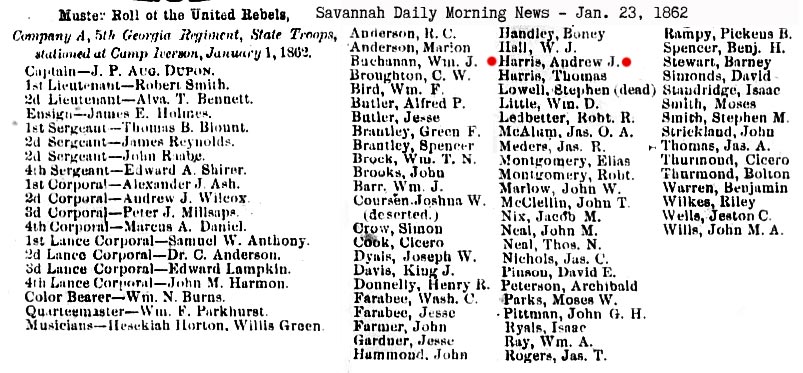
Savannah Daily Morning News,
Jan. 23, 1862
|
Andrew J. Harris was elected Second Pioneer
of the Russell Hose Company on Aug. 28, 1874
In Savannah he was
noted as a "quick man and par one" in studying fire conditions.
He applied himself to this work and was an assistant engineer later
in the Savannah Department. While in Savannah, his
half-brother, George Morris (of Tampa) was born, and it was in
Georgia that A. J. married Miss Mary Elizabeth McGrill. [Probably McGill.]
|
 |
|
 |
In Feb. of 1875, the topic of
jury exemptions was apparently a hot issue, and so the
Savannah Daily Morning News undertook to investigate the fire
department to see if they were exceeding the maximum number of
of state-allowed exceptions--480.
They found that exactly 480
exemptions were being claimed by the department.
The article at left has been
edited and rearranged so that only the Russell Hose Company
appears, along with the recap of all the companies at the end.
If you wish to see the entire
article showing the names of the exemptions for all 10
companies,
click here to see the full article larger, then click it
again to see it full size. |
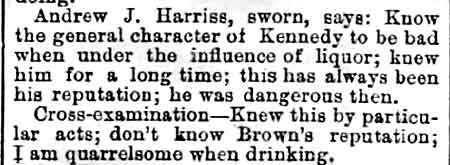 On
March 20, 1876, Harris was one of the character witnesses in the
State of Georgia vs. Dukes Brown, a murder trial. Harris
testified as to the character of the victim, whom he had known for
"a long time." On
March 20, 1876, Harris was one of the character witnesses in the
State of Georgia vs. Dukes Brown, a murder trial. Harris
testified as to the character of the victim, whom he had known for
"a long time."
You can see the whole article here at the Georgia Historic
Newspapers website. It is a free site.
1880 Census, Savannah, Ga., Zubby Street

Andrew J. Harris and
wife Mary E. Harris lived in the same dwelling as Charles Clark, a
painter from Maine. A. J. was a cabinet maker. Both his
parents were from England, his wife Mary E. was born in Georgia.
This census indicates both her parents were from Georgia, but later
censuses show otherwise. A.J.'s age here is quite a bit
underreported, he would have been 41 or 42 in 1880. This large
of an age discrepancy is not uncommon for married couples with large
age differences.
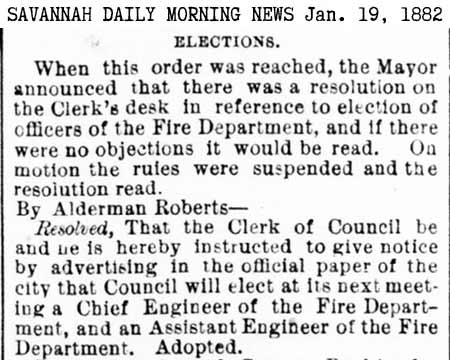
At left: January 18,
1882 - The city council of Savannah passed a resolution to instruct
the clerk of the council to start advertising in the official
newspaper that the city would be electing a Chief Engineer and an
Assistant Engineer for the fire department.
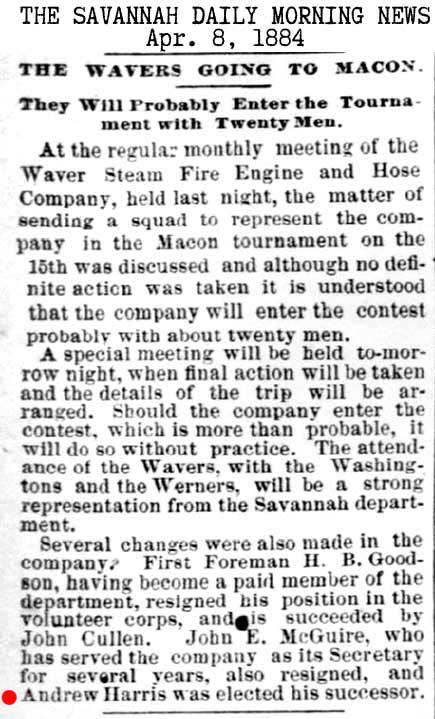
At right: Harris was
elected as Secretary of the Wavers Steam Fire Engine and Hose
Company to replace John McGuire who resigned to become a paid member
of the department.
Below:
On June 15, 1886, Harris was involved in an altercation between a
Savannah police officer and a suspect being arrested for being drunk
on the street and trying to break into a house. The arresting
officer, Hall, had the suspect in custody and was leading him down
the street when a crowd began to gather. Officer McDermott,
who from his office saw Hall having difficulty restraining the
suspect, went out and across the street and offered to restrain the
suspect while Hall went to call the station for a wagon to take the
suspect to the barracks. Then, someone in the crowd remarked,
"Here comes another officer" and shortly, someone in civilian
clothes (Officer Rogers) arrived in "hot haste," grabbing the
suspect by the collar with one hand and struck him on the side of
the head with the other. " McDermott remonstrated with Rogers at
which point Rogers struck McDermott in the face with his fist.
McDermott later said to The Daily News, that after being struck, he
turned the suspect over to officer Hall who had just returned, and
"immediately returned the blow with interest."
By this time a large
crowd had formed and "pressed close around the policemen."
Rogers told The Daily News that McDermott caught hold of him to pull
him away, and then tried using his club, but someone knocked him
(Rogers) down. While Rogers was down, he was kicked in the
back and about his body by someone in the crowd. As Rogers
sprang up, he drew his pistol and kicked at the nearest man to him,
who happened to be A. J. Harris, former foreman of the No.2 Engine
Co. Harris told The Daily News the next day that he was not a
willing participant in the disturbance, he was just passing along on
the street with his wife on their way home when he was struck by
someone in the crowd, whom he afterwards recognized as Officer
Rogers.
Rogers finally pointed
his revolver at the crowd which quickly gave the men plenty of room.
All the while the scuffle was going on, Officer Hall was struggling
with the suspect (Edward Paine) so Hall was unable to assist Rogers,
who was hit in the face and sustained a slight cut under his chin.
After order was restored, Rogers helped Hall take the prisoner to
the barracks. The crowd followed but gave no more trouble.
Harris went to the
Magistrate and had a warrant issued for the arrest of Officer
Rogers. Later, Rogers, who had good reputation on the force,
and was known as a "plucky" officer, stated that Harris was one of
the crowd who had attacked him. McDermott told the Savannah
newspaper that the only mobbing Rogers received was administered by
him (McDermott.)

Ultimately, several
names were placed on the docket for this case, and "a lively time"
was expected Friday morning before the Mayor. On the
17th, The Morning News published an article (below) with McDermott's
and Harris's version of the event but nothing concerning the court
session was printed through Monday, June 21 in the Savannah Daily
Morning News. On June 23 the SDMN reported "the docket cases
against Constable Frank McDermott were dismissed yesterday morning
by the Mayor."

This is the last
mention of Harris in the local papers available online, before he
came to Tampa.
There was another Andrew J. Harris in another county who was in the
papers for run-ins with the law.
THE A. J. HARRIS
FAMILY COMES TO TAMPA
Harris came to Tampa with
his wife in the fall of 1886, continuing his career in furniture as a dealer in
mattresses and furniture, also doing work as a general upholsterer.
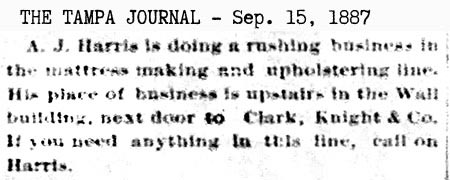

The Wall building was
the location of the late Billy Washington Wall's mercantile
business, which became Clarke & Knight's hardware. Billy
Wall's son, Perry G. Wall (future mayor of Tampa) was a minor when
his father passed away, so his uncle, E. A. Clarke (another future
Tampa mayor) controlled Perry's interest in the business until Perry
turned 21. At which point, Clarke & Knight became Knight &
Wall Hardware. Read about Knight & Wall and these events
here at this TampaPix feature.
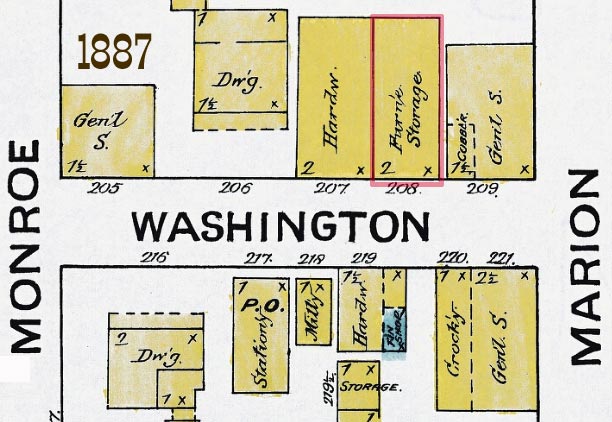
This 1887 Sanborn map from the UF
Digital Library Maps Collection shows a block of Washington St.
between Monroe (later named Florida Ave.) and Marion St. with the
only furniture-related business next to a hardware store in a
2-story structure.
In 1888, Chief A. C. Wuerpel, Harris, and president
of the First National Bank T. C. Taliaferro, organized a volunteer fire
department which quickly grew from a one-horse affair to a
department which any city should be proud of.
On May 5, 1889, Harris was
appointed by City Council as First Assistant to the chief, with
Manuel Rodriguez as second assistant, and Augustus
"Gus" C. Wuerpel chosen by the City Council as Chief
of the volunteer department.

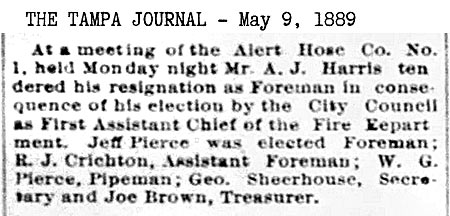 At left: A.J. Harris
resigned as the foreman of the Alert Hose Co. so he could
take the position as First Assistant Fire Chief. Jeff
Pierce was elected to fill Harris's position as foreman.
|
|
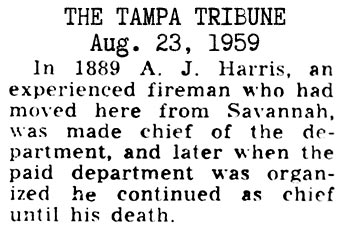 Karl
Grismer in his History of Tampa, 1959,
makes an erroneous statement concerning the
appointment of Harris as chief of the fire department, as does D.B.
McKay in Pioneer Florida: Karl
Grismer in his History of Tampa, 1959,
makes an erroneous statement concerning the
appointment of Harris as chief of the fire department, as does D.B.
McKay in Pioneer Florida:
On
May 18, 1889, A. J. Harris was appointed chief and
competitive fire drills were held regularly. An electrical
fire alarm system was installed December 9..."
In the Aug. 23, 1959 Tampa
Tribune, D. B. McKay recounted his memories of the volunteer
fire department in a Pioneer Florida column "Chief Soaked in
Jackson Street Ditch Water." About halfway through the
column, McKay made the same erroneous statement as you see
at right. No surprise since D.B. McKay was
Grismer's
editor. McKay's memories at that point were 70 years
old.
It wasn't until after Wuerpel's resignation in June of 1890 that the city
appointed Harris as Acting Chief to lead the
department and improve training.
|
Read about Tampa's first Fire Chief
August C. Wuerpel, as
well as his resignation letter,
here in this feature at TampaPix.
|
FIRE
DEPARTMENT FESTIVITIES
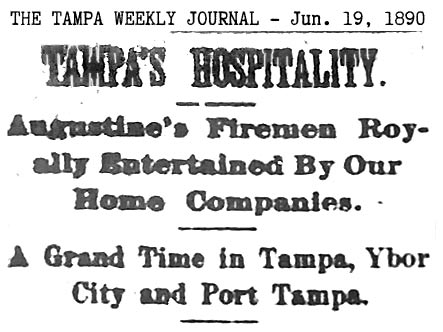 This Tampa
Journal article published Thursday, June 19, 1890 describes
the St. Augustine's firemen's arrival in Tampa on Monday,
June 16 and the TFD festivities held in Tampa on Tuesday, June
17, 1890. It is filled with details of the numerous
contests between the volunteer fire companies and the
celebratory atmosphere that prevailed in that era. This Tampa
Journal article published Thursday, June 19, 1890 describes
the St. Augustine's firemen's arrival in Tampa on Monday,
June 16 and the TFD festivities held in Tampa on Tuesday, June
17, 1890. It is filled with details of the numerous
contests between the volunteer fire companies and the
celebratory atmosphere that prevailed in that era.
Read
the entire article, click it after it opens to see it full
size. |
|
Excerpts from the
article:
The St. Augustine Fire
Company arrived on Monday night by mail train. They
were met at the depot by various hose companies of the
city and escorted to the Booz House where they were
staying. The parlor and halls of the hotel soon thronged
with jolly fire laddies. Supper was announced and
all filed into the long dining room making a notable
showing of good looks and muscle. The evening's
entertainment closed with an address of welcome by City
Clerk Lamont Bailey. Response of appropriate words
followed by the Chief of the St. Augustine Fire Dept. John
H. Dowd.
|
THE
BOOZ HOUSE (Not from the article)
The old Palmetto Hotel on Franklin St. went up
for sale on Jan. 3, 1889 and took nearly a
year-and-a-half to sell. in the meantime, J.
W. Booz became manager of the hotel in early 1890
and would continue as the manager after it's sale to
Capt. R. F. Webb for $10,000 was announced May 1,
1890.
|
| |
|
|

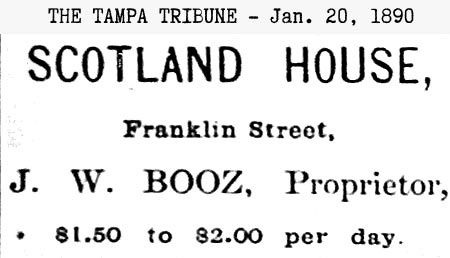 |
 |
|
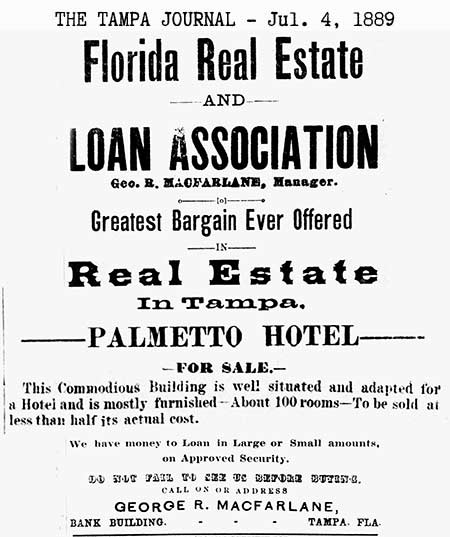 |
| |
|
|
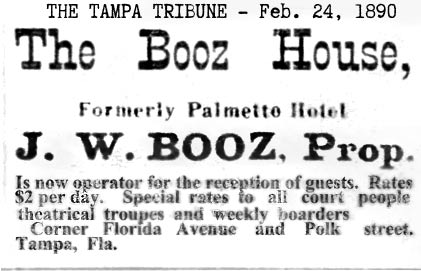 |
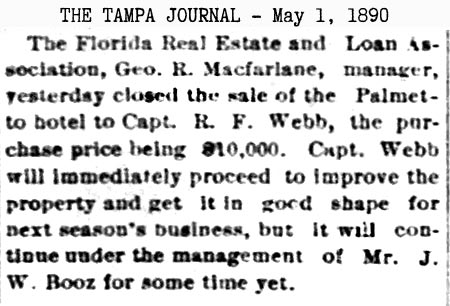 |
| |
|
FIRE
DEPARTMENT FESTIVITIES continued
Tuesday's contest: By 7
a.m., various Tampa fire companies were assembling at
their reel houses. Everywhere in the streets, groups
of people were forming to watch the events. By 9 a.m. the
streets were crowded along Lafayette between Franklin and
Ashley. It was a sunny day. Shortly after 9
a.m. the judges and timekeepers took their places.
The Alert hose company
was the first to run. Their first run a kink in
their hose kept them from attaching the nozzle correctly
and they failed to hit the flag with their first try.
They made a 2nd attempt and their total time was 45
seconds. The Resolute hose company was next.
They hit the flag without mishap at 35 seconds. The
Ponce de Leon company of St. Augustine was next, comprised
of 17 men. Their time was 47 seconds. The Humanity
company was next. It was comprised of "our Cuban
citizens from the Fourth Ward." "Our nimble-footed
Castilian citizens made an astonishing run." Their
time was 41 seconds. The Invincibles was next.
They were comprised of the juvenile company of Tampa; boys
from age 10 to 13 residing in the First Ward. They
were given a half-distance starting point "amid laughter
and cheer of the crowd." They passed the hydrant at
30 seconds and the timekeeper "lost the record" and the
exact time wasn't kept. Spectators marked their time
at 40 seconds but the exact time wasn't kept. The
"kids" were highly elated at their record.
Round after round of
cheers was given by all for the victorious Resolutes.
The crowds dispersed at 11 a.m. and all boarded the train
for a trip to Ybor City.
On arrival in Ybor City,
they formed in a line in this order. Chief of
Police, Squad of Police, Secretary Lamont Bailey and
Second Assistant Chief Barbentine [Balbontine], the
Ancient City Coronet Band, the Chief of the St. Augustine
fire department and foreman of the Ponce de Leon Company,
the Ponce de Leon Fire Company, the Tampa Companies:
Resolute Hose Co., Humanity Hose Co., Phoenix Hose Co.,
Alert Hose Co., and Mirta Hook and Ladder Co.
Marching to the music of
the band, they paraded to Station No. 2 of the Tampa Fire
Dept. where refreshments were served and a speech made by
Acting Chief A.J. Harris. Secretary of the
Fire Department Lamont Bailey introduced George T.
Chamberlain, Chairman of the Committee on Water Works and
Fire Dept. of the former Council and "as the man to whom
the City is largely indebted for its present ample and
efficient protection against fire." Some "laddies
indulged in private contests on the ladders" and a good
time was had by all.
At noon the march resumed
to the reel house of the Relief Hose Co. for the
inspection of the apparatus. Then they boarded the
12:30 train and returned to Tampa for dinner. [We call it
lunch now.]
Picnic at Port Tampa -
Firemen and their guests, along with the Ancient City
band, took the Tuesday 2:30 train to Picnic Island where
refreshments were served: coffee, sandwiches, ice cream,
cake and lemonade. Sea bathing, swinging and
informal dancing was "indulged in by the care-free throng.
Hammocks provided by the managers of the island were in
constant use, and the shady grounds proved a pleasant
retreat."
The Firemen's Ball - It
took four coaches on the 7:30 p.m. train to take the
firemen and their lady friends to the grand ball in the
pavilion at Picnic Island. Programs for the ball had been
made in advance by the Ponce de Leon Fire Co. of
Jacksonville. Well-arranged and carried out to the
letter, the band furnished excellent dance music.
The refreshment saloon adjoining the dance hall was
liberally patronized throughout the evening.
At 10:30 the crowd was
startled by the sudden illumination of the grounds with
colored lights which created a magical and weirdly
beautiful effect arranged by the managers of the island.
The effect then faded leaving the area in relative
darkness.
The next morning,
Wednesday at 7:30 a.m., the Ponce de Leon's were escorted
by officers and members of the Tampa companies to the
train and bid them farewell. The St. Augustine fire
chief called his men into line and thanked them, then was
followed by three cheers and a tiger three times over in
honor of the Fire Chief and officers, then for our bonny
fire laddies and lastly for the Mayor and citizens in
general from whom they had received many courtesies.
Words of praise were given for the generous entertainment
provided.
|
ACTING CHIEF HARRIS RUNS FOR FIRE CHIEF
On June 26, 1890, the Tampa Journal
announced "Mr. A. J. Harris who has tendered his resignation as assistant
chief of the fire department explains that it is not to take effect until
his successor is appointed and qualified. Mr. Harris further states
that he has resigned the position so that he may be unencumbered in the
race for chief which he proposes to enter." |
On July 28, 1890, the Savannah Daily Morning News reported that up until
June 30th of that year, the Tampa fire department has cost $14,174.14.
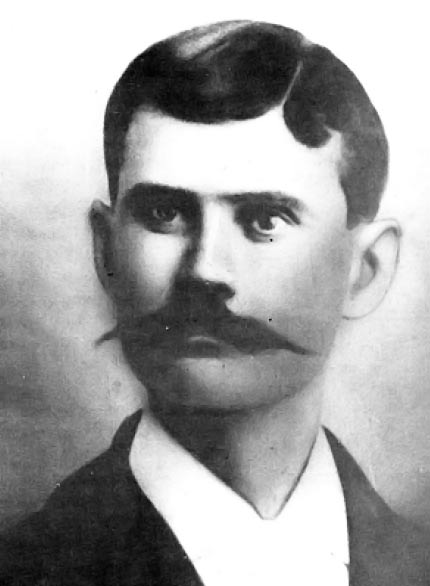 On
August 11, 1890, the new main fire station of the Fourth Ward was
dedicated. It was for use by the Mirta Hook & Ladder Co. No. 1 and
the Vigilant Hose Co. No. 6. Present at the dedication was President
of the City Council, R. H. Webb; presiding, Acting Chief A. J. Harris,
City Clerk Lamont Bailey, Foreman of the Mirtas; Francisco Puglisi, and
Acting First Assistant B. M. Balbontine. The Humanities Hose Co. was
also offered quarters in the main station, but they declined because they
would have been at the rear of the building making it "impossible for them
to get out to a fire as quickly as the Mirtas or Vigilants." On
August 11, 1890, the new main fire station of the Fourth Ward was
dedicated. It was for use by the Mirta Hook & Ladder Co. No. 1 and
the Vigilant Hose Co. No. 6. Present at the dedication was President
of the City Council, R. H. Webb; presiding, Acting Chief A. J. Harris,
City Clerk Lamont Bailey, Foreman of the Mirtas; Francisco Puglisi, and
Acting First Assistant B. M. Balbontine. The Humanities Hose Co. was
also offered quarters in the main station, but they declined because they
would have been at the rear of the building making it "impossible for them
to get out to a fire as quickly as the Mirtas or Vigilants."
Francisco Puglisi
photo courtesy
of The Sunland Tribune, Journal of the Tampa
Historical Society, Vol. 3, No. 1 - Nov. 1977, Hampton Dunn,
editor, "The
Italian Heritage in Tampa" by Tony Pizzo.
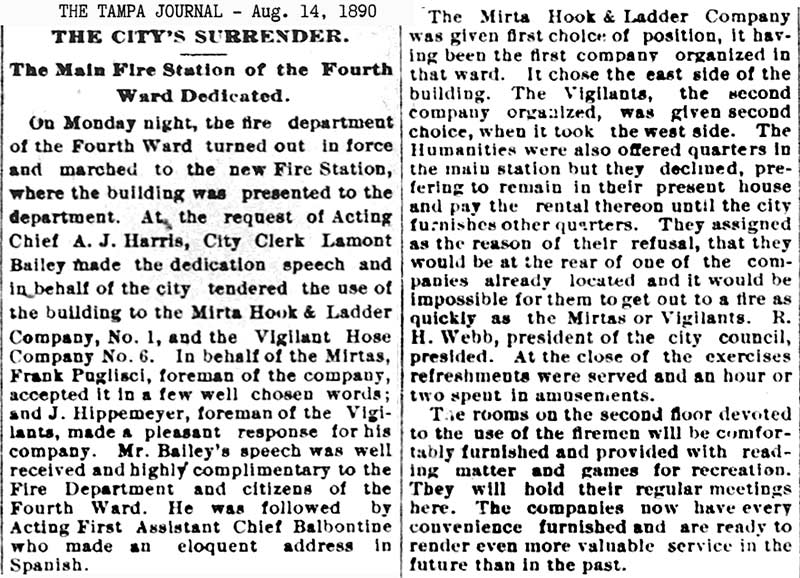
|
| Thomas C. Taliaferro, 2nd elected
chief of the Tampa volunteer fire department
In an election held on Aug. 29, 1890, T.
C. Taliaferro was chosen as Fire Chief over C. E. Harrison, and B. M.
Balbontine was chosen as First Assistant Chief over A. J. Harris.
It isn't known why Harris decided to run for Asst. Chief instead of Chief. Other matters handled at this session of the City Council meeting have
been edited out.
|
|

|
|
 |
|
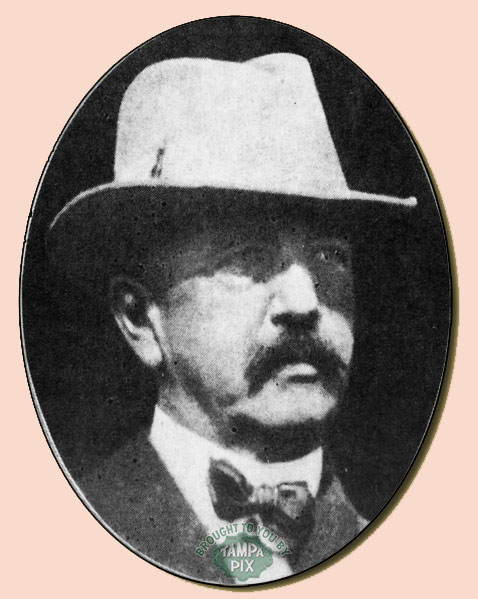 |
|
Thomas Carson
Taliaferro
From a Jan. 3, 1993 ad about the merger of First Florida Bank
with Barnett Bank, in Florida Today (Cocoa Beach)
|
THOMAS CARSON TALIAFERRO
2nd elected Chief of the Tampa volunteer fire department
(From Karl Grismer's
History of Tampa - Biographies pp, 337-338)
Thomas Carson Taliaferro was
born July 19, 1859 at Orange Courthouse. Va. When a young man he went to
Jacksonville, engaged in the lumber business, and then joined the banking
firm of Ambler, Marvin & Stockton, the oldest bank in East Florida. In the
fall of 1885 members of the banking firm founded the Bank of Tampa and Mr.
Taliaferro came here to become cashier of the institution, the first bank
Tampa ever had.
On May 6, 1886, the bank
received a national charter and its name was changed to the First National
Bank. Mr. Taliaferro served as president of the bank from 1903 to
January, 1927 when he was made chairman of the board. He was
directing head of the bank for 47 years.
In his younger years he was
active in sports and often umpired baseball games in Tampa. He also
served as chief of the volunteer fire department. In later life he devoted
his full time to banking and succeeded in making the First National one of
the leading banks of Florida.
T.C. married in Tampa to
Stella Morrison, daughter of William A. Morrison and Elizabeth Hinton,
whose homestead was known as the Morrison Grove.
He died April
11, 1928 in Baltimore, Md. He was survived by his widow and five children:
Edmund Pendleton, William M., Thomas C. Jr., Mrs. M. B. (Stella) Withers,
and Mrs. Andres Iglesias. He was also survived by two brothers, the
former U.S. senator James Pendleton Taliaferro of Jacksonville, and W. R.
Taliaferro of Charlotte, N.C, and a sister, Lucy Taliaferro, of Orange
Courthouse, Va.
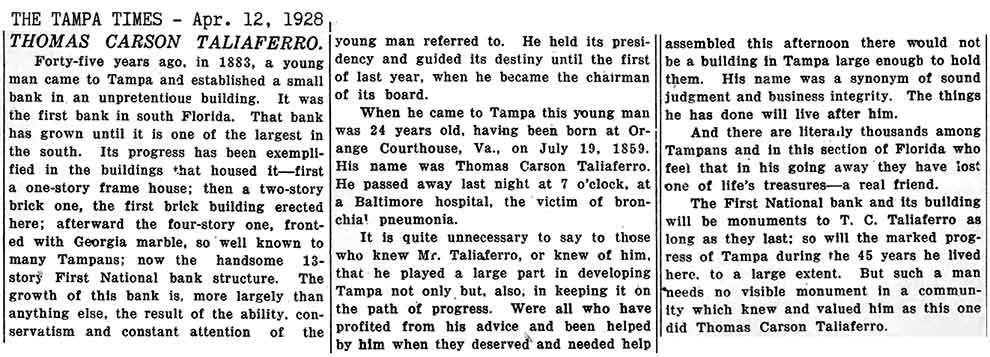
The photo below can be found numerous times on
the web with white lettering on the front facade sign board,
"First National Bank of Tampa." In Tampa Bay History Magazine,
journalist Hampton Dunn states that the structure was located on
Washington St. near Franklin St. and that an early-time photographer
painted the "First National Bank of Tampa" lettering on the
negative (white lettering on the print indicates black lettering on
the negative.) This was the first home of The Bank of Tampa,
but the photo was taken LONG after they vacated it. In fact,
the Bank of Tampa did not become the First National Bank until they
moved into their third location, a 4-story bldg. at Franklin and
Madison St. around 1900--evidence that the photo was taken
after 1900.
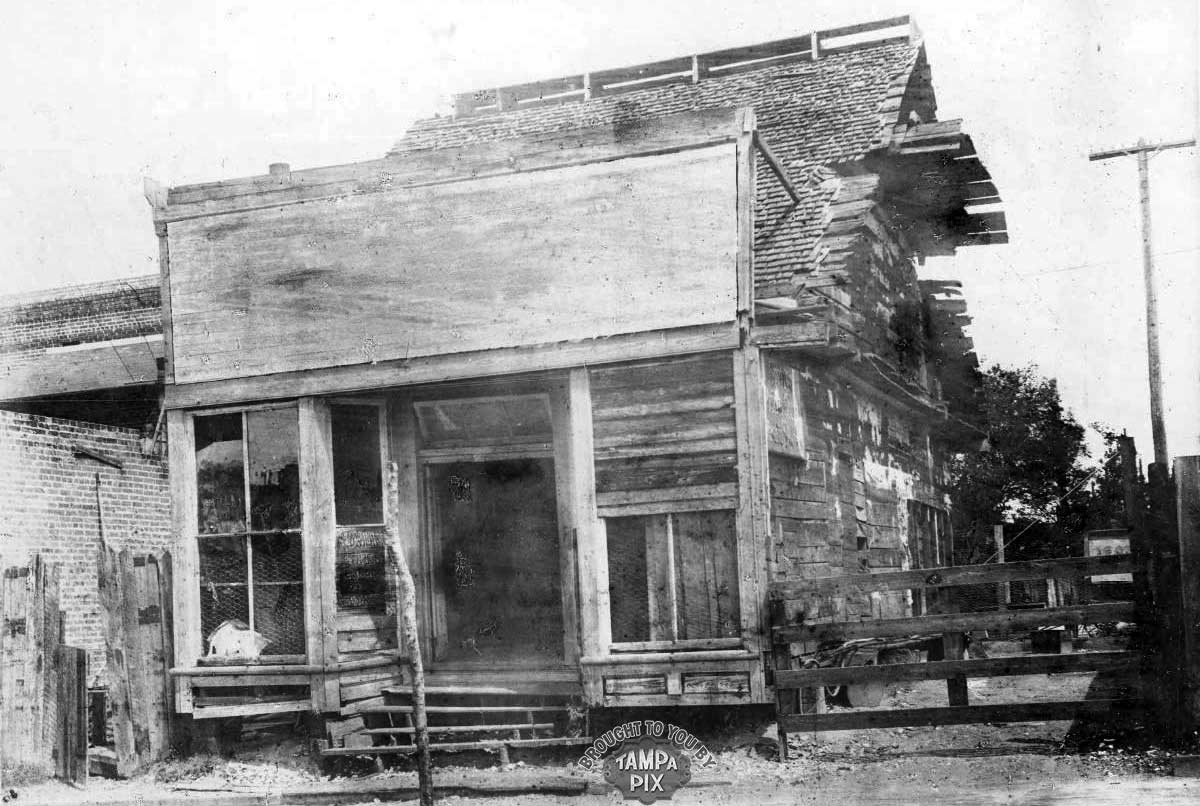
See the bank's 2nd location, the first
brick building in Tampa, at the feature about Fire Chief A. C.
Wuerpel
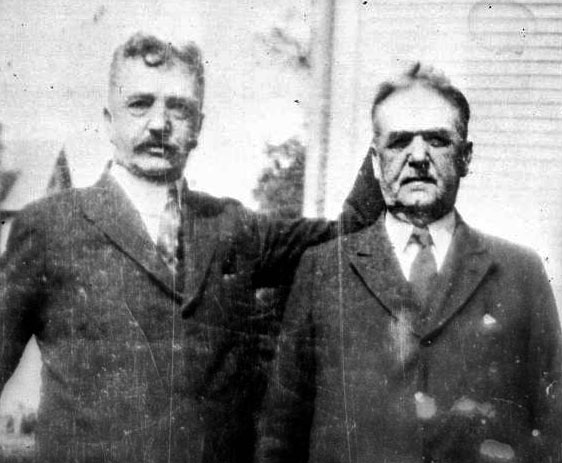
Thomas Carson Taliaferro, Sr. and his brother,
U.S. Sen. James Pendleton Taliaferro. Circa 1920s.
Photo courtesy of State Archives of Florida, Florida Memory project.
In 1883, Henry B. Plant began
building his South Florida Railroad and Tampa started booming as it had
never boomed before. And because of the boom, Tampa got its first
bank, an affiliate of Ambler. Marvin & Stockton, of Jacksonville, the
oldest bank in East Florida. The senior member of the banking firm, David
Griffith Ambler, had close connections with Plant and knew that the South
Florida would be completed. So did Ambler's business associate, James P.
Taliaferro, and his bank partners, John L. Marvin and John N. C. Stockton.
The four men agreed that, with the railroad in sight, Tampa was a city
with a future, and they joined forces to establish Tampa's first bank
which they named the Bank of Tampa. It was opened Nov. 3, 1883, in a small
building on Washington Street, with Thomas Carson Taliaferro,
younger brother of James Taliaferro, as cashier. The first day's deposits
totaled $5,636. (From Karl Grismer's
History of Tampa, p. 306)
When Vicente Martinez Ybor purchased the first 40 acres in what became Ybor
City, Ignacio Haya
allowed Ybor to take the first step in real estate. Once he was
convinced of its success, he purchased land, forming the Sanchez and Haya
Real Estate Company. Haya then constructed a two story wooden factory at
the corner of Seventh Avenue and 15th Street. During construction, he
visited a local Tampa banker, Thomas Taliaferro, to inform him that
he and Sr. Ybor need an institution of credit to facilitate the
transactions involving purchases, sales, collections, and wages for their
employees. At the time, the business of the bank was so slim, the young
cashier in charge, T.C. Taliaferro, came within a hair of leaving town. In
fact, he’d already packed the fixtures and was ready to return to
Jacksonville when the good news came. At first, Taliaferro was
unsure about the success of the cigar business in Tampa, but when Haya
assured him that initial salaries would amount to more than $10,000 a
month, Taliaferro now decided his future was in Tampa. Thanks to the
influence of Sr. Haya, he became a successful Tampa banker, and founder of
today's First National Bank. (From The
Sunland Tribune, Volume 6, No.1 November, 1980 Journal of the TAMPA
HISTORICAL SOCIETY Tampa, Florida.)
Tampa City Council - August
13, 1885 – August 13, 1886
William T. Haskins, President, Harry L. Branch, William Benton Henderson
[two year term], Thomas Edward Jackson [two year term], Silas A. Jones,
Henry Laurens Knight, George Bascom Sparkman, Thomas Carson Taliaferro
[two year term], Dr. John Perry Wall [two year term]
Note: The four new members cast lots at the new council's organizational
meeting on 8/13/1885 and determined that William T. Haskins and Thomas
Carson Taliaferro would serve two year terms.
From Tampa's City Councils |
|
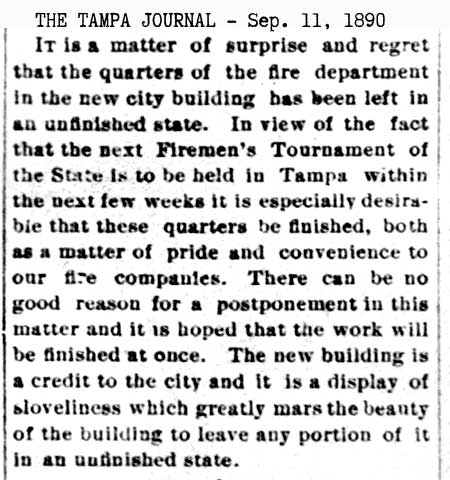 Sept. 11, 1890 - THE TAMPA JOURNAL: "Chief Taliaferro is taking an
interest in the fire companies, is getting the organization on a business
basis, which demonstrates the fact he is the right man for the position." Sept. 11, 1890 - THE TAMPA JOURNAL: "Chief Taliaferro is taking an
interest in the fire companies, is getting the organization on a business
basis, which demonstrates the fact he is the right man for the position."
At right: The quarters for the fire
department in the new City Hall building in the First Ward were yet to be
completed.
See issues with the
contractor in the A.C. Wuerpel feature.
Sept. 18, 1890 - THE TAMPA JOURNAL
City
Council resolutions - "From Committee on Water Works and Fire Dept.,
recommending that A. J. Harris be appointed Superintendent of the Electric
Fire Alarm Telegraph--also storekeeper at a salary of $40 per month.
Adopted.
Oct. 16, 1890 THE TAMPA JOURNAL
The plasterers are at work in the firemen's headquarters in the city hall.
The intention is to have the room completed before the meeting of the
State Firemen's Association.
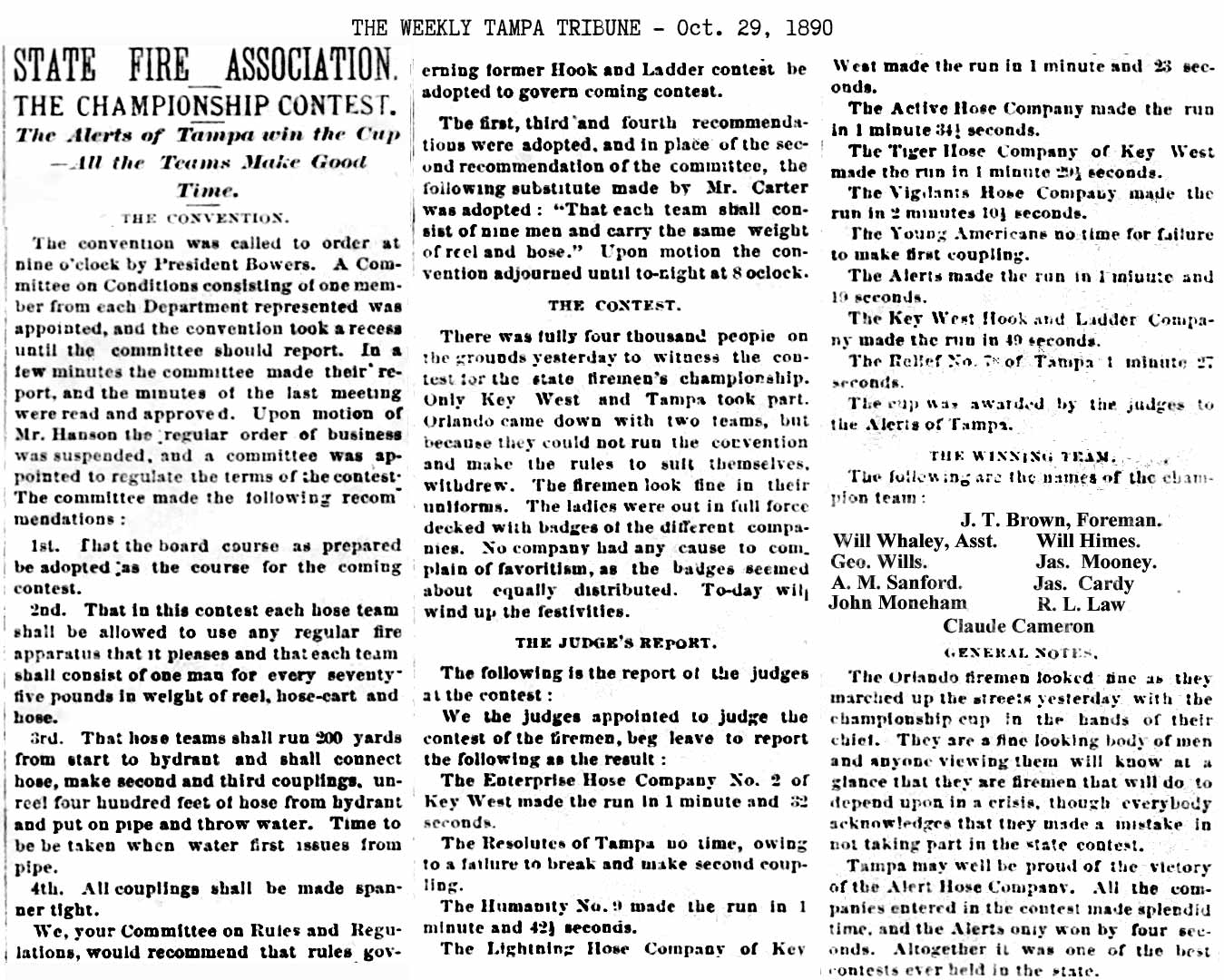
Dec. 5, 1890 - The Savannah Daily Morning
News reported that Capt. Dixon presented the Tampa fire department on
Thanksgiving day with a check for $200 and a receipted bill for lumber
amounting to $51 in recognition of their services in saving his mill
during the late fire in Tampa. |
|
May 25, 1891 - The city
clerk published this notice to inform the members of the various fire
companies that they will meet on May 27 to choose a chief and two
assistants. |
On May 26, 1891, Chief
Taliaferro requested that the election include a third assistant chief.
His request was granted. |
|
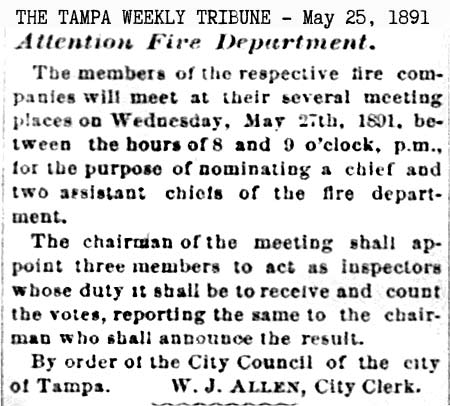 |
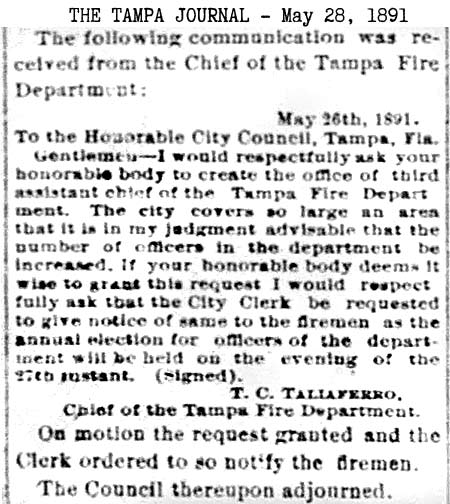 |
| |
|
|
On May 28, 1891, the
results of the election were published, indicating T. C. Taliaferro was
chosen in an overwhelming vote over Otto Kammerer.
|
A. J. Harris was elected
Vice President of the Alert Hose Co. on June 8, 1891. |
|
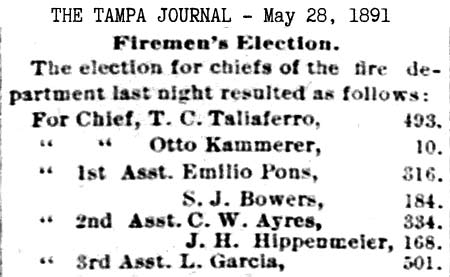 |
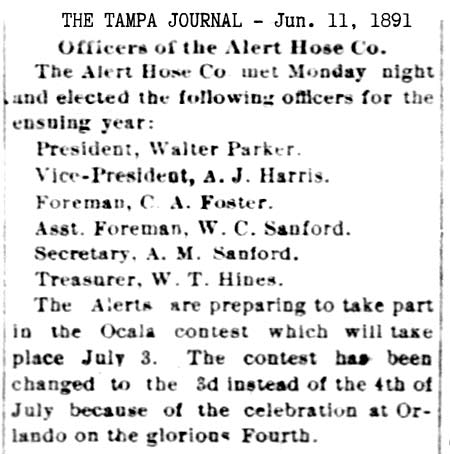 |
Praise for Tampa's Water Works and Fire Dept., Criticism of its Electric
Utilities
On Aug. 25, 1891, an expert inspector J. S. Altreds of the Liverpool &
London and the Globe Insurance Co. gave report to the Tampa Tribune of his
conclusions concerning Tampa's water works, fire department, and
electrical systems. The water works and fire department received
accolades, but the city's electric lighting system and power lines were
poorly designed and in very bad condition.
The electric fire alarm system telegraph
should have been built in at least 3 circuits. Instead, it was all
on one circuit, so if any part of the system failed, the whole system
failed. One such failure took place while conducting his
investigation. A storm caused a power line to fall and cross the
alarm telegraph lines, apparently not short-circuiting it, but to prevent
damage to the the system, Chief Taliaferro had to disconnect all the alarm
boxes and bells.
Of the city's electric light system, he
stated:
"Your electric light construction,
if it can be called such, is open to the severest criticism.
Inferior material has been used, particularly for outside construction.
Wires have been run in all directions and are attached to buildings,
sheds and roofs, at the most convenient points and transformers are also
promiscuously located on buildings, sheds, roofs and poles. That
you have not had serious accidents to both life and property is
wonderful. The time is not distant when the insulation, already so
defective, will become so defective. will become so entirely worthless
that accidents will be certain to occur. Your city is also
festooned with dead wires belonging to the plant discontinued some time
ago. No time should be lost in removing them as they are a
constant menace to life and property.
He goes on to describe the dangerous
condition of inside wiring all over the city, citing as an example the
Western Union telegraph fuse box. In closing, he says he was
impressed with how advanced Tampa's water works and fire protection system
was compared to other cities, and had confidence that Tampa would repair
the electric lighting system to satisfaction.
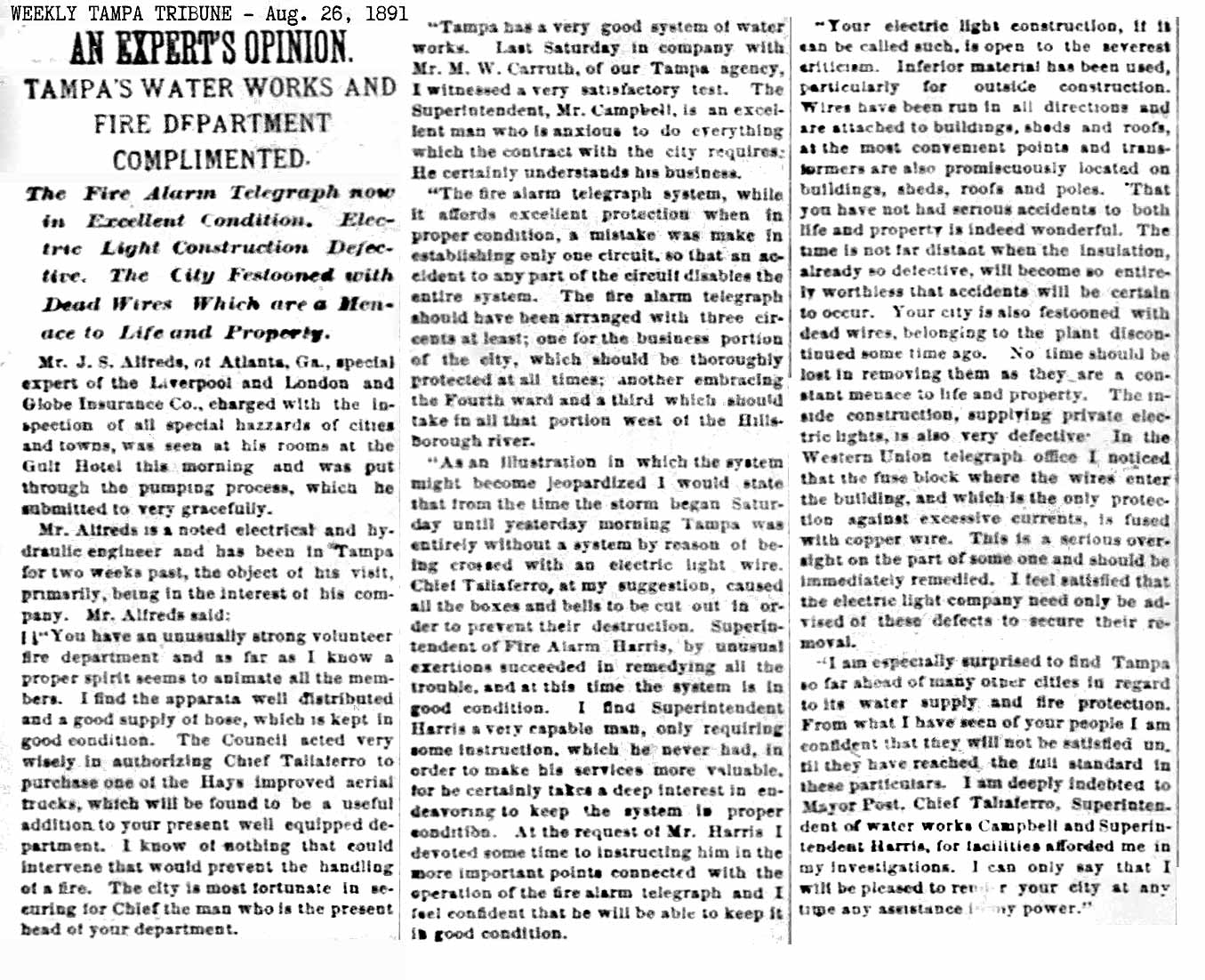 |
Disastrous Fire
in Ybor City
On Nov. 12, 1891, the Sanchez & Haya cigar
factory in Ybor City caught fire. Firefighters
were hampered by alarm and telephone wires in poor
condition, and low water pressure. Eight fire
companies were on scene but the wooden buildings
burned like match boxes. It only took half an
hour for a small hotel to burn to ashes.
1891 November 12,
- a fire breaks out in the Aurelio Campos restaurant
on 7th Avenue, between 14th and 15th Streets. At the
end destroys two and a half city blocks
Cigars of Tampa
The fire consumed 2 hotels, a boarding house, 4
warehouses, 3 barber shops, a drug store, 4
restaurants, 6 grocery stores, 6 dry goods stores, a
jewelry store, a boot and shoe store, and the market
house. The article claims that all the
buildings in the Fourth Ward were gone, with losses
estimated at $350,000 and only about $125,000
insured.
|
|
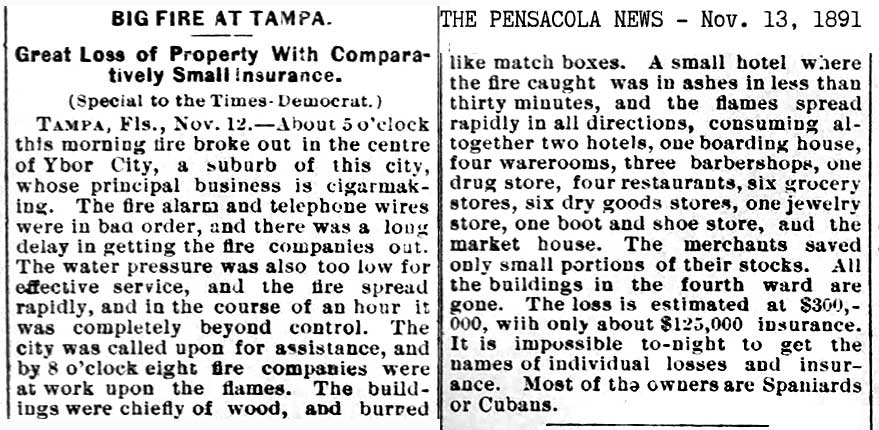 |
| |
During the
fabulous pioneer days of Ybor City the famed Hotel
De La Havana was located on the corner of 15th St.
and 7th Ave.. The three story frame structure was
the first hotel erected in the Latin Quarter. Its
proprietors were Jose Rubin and Jacinto Olavarria.
The hotel was headquarters for newly arrived tobacco
workers and Cuban political exiles. The building was
destroyed during Ybor City´s first great fire in
November 1891.
Historic Markers Across Florida
|
One of the
restaurants destroyed was Las Novedades which was
located in the middle of the block where the red
circle indicates.
|
| Before the Fire
B=Barber shop,
C=Cigar factory, D=Dwelling, H=Hotel, M=Meat market
(circle marks where Las Novedades cafe was located
in 1891),
R=Restaurant, Rx=Drug store, S=Saloon,
?="El Bazar" possibly a hotel.
Sanborn Fire Insurance Map from University of
Florida digital map collection
|
|
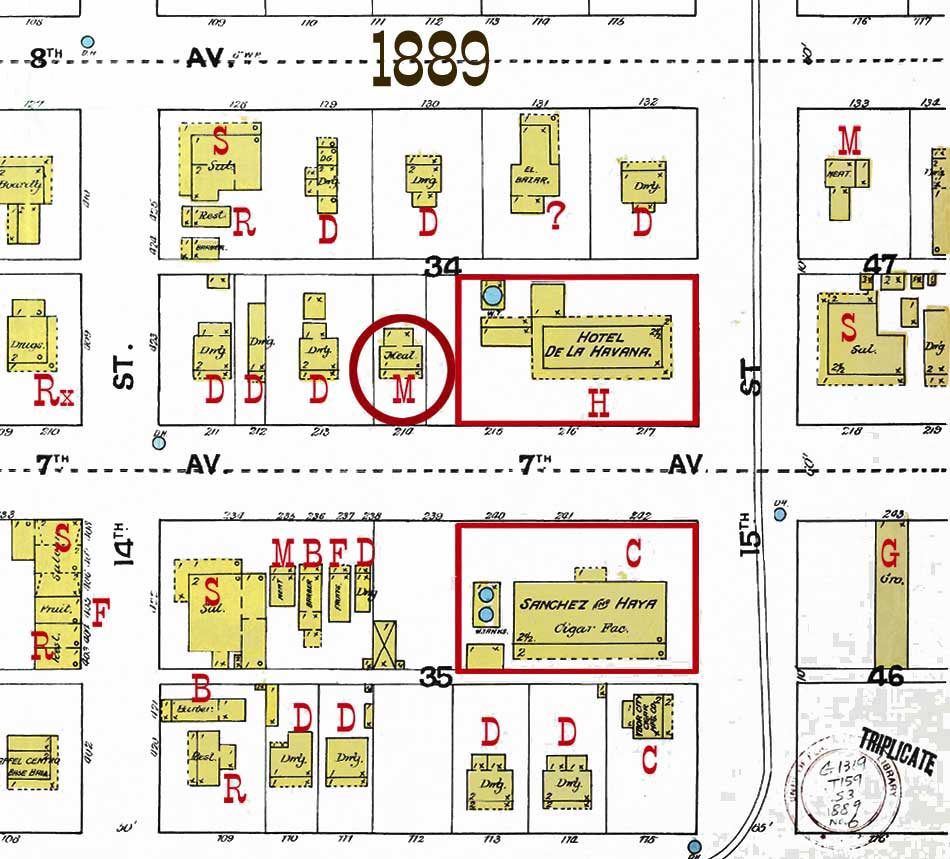 |
| |
Jefferson Sanders of the
Eagle Hose Company No. 10 is eulogized for his heroism at
the Sanchez y Haya fire of 1891.
No mention is made of how or why he died, and no other
info could be located.
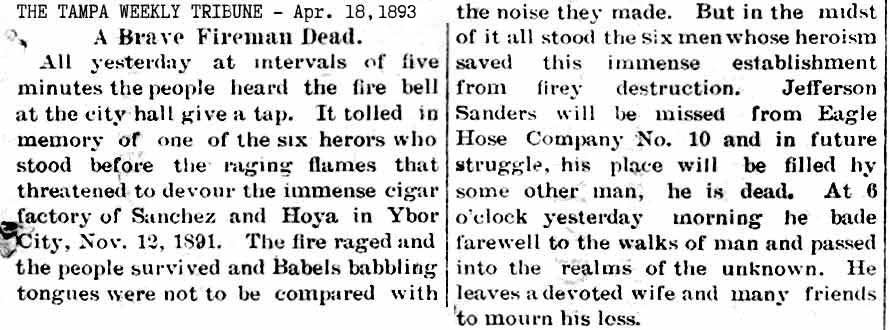
|
Jun.
24, 1893 - Tampa fire chief A. J. Harris travelled
to Savannah, Ga. The article states he had
left Savannah for Tampa "a little less than 8 years
ago" putting his departure at early as 1885.
However, articles earlier presented here concerning
his altercation with police officers confirm he was
there in 1887. |
Nov. 3,
1893 - Member of the committee to investigate the
condition of the fire dept. equipment, George T.
Henderson, reported that all the hoses were tested
at highest possible pressure and were able to throw
a stream of water high enough to reach the top of
any building in Tampa. |
|
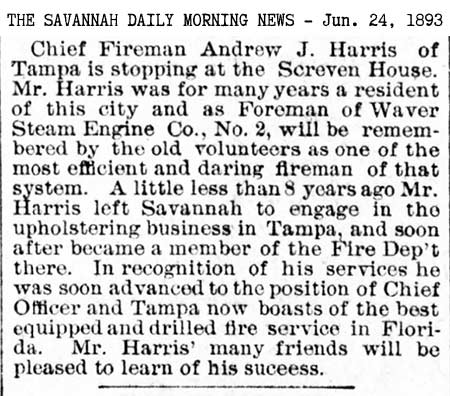
Below:
Nov. 3, 1893 - The first paragraph of a longer
article:
Chief Harris and superintendent of the water works,
W. A. Campbell, reported that water company
customers weren't turning off their lawn sprinklers
when fire alarms were being sounded (thus causing
low pressure to fight fires.) They asked for
an ordinance to assess a fine for patrons violating
the ordinance. |
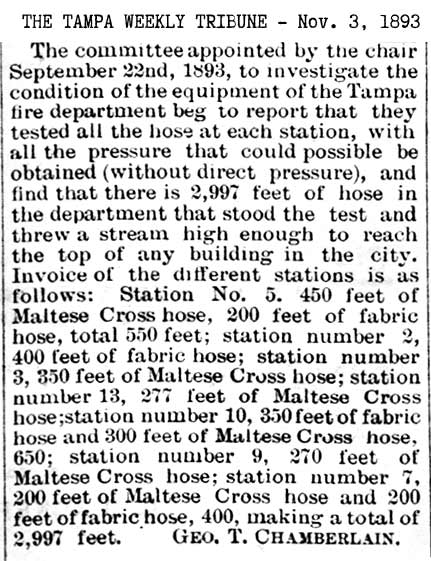 |
|
 |
Below: Dec. 29, 1893 - Chief Harris was training
two recently purchased horses for fire department
use. The horses were named Peter O. in honor
of councilman Peter O. Knight, and George T., in
honor chairman of the finance committee and former
fire committee member George T. Chamberlain. |
|
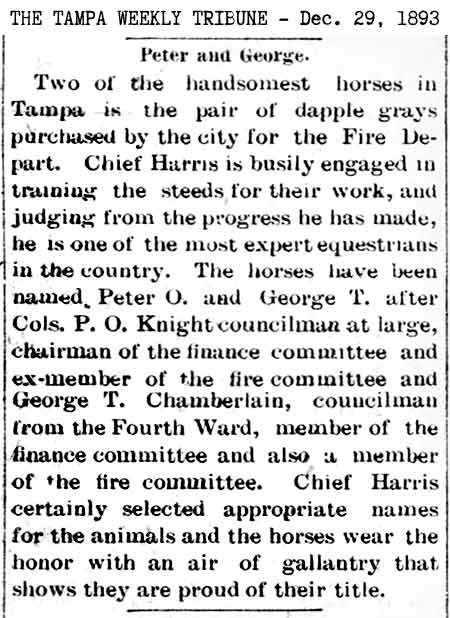 |
|
The
rest of the article above: |
|
|
In
another communication received by the city council,
Chief Harris called attention to the neglect of the
various electric light and street railway companies
in conforming with the rules of the Southern Tariff
Association (fire insurance rates.) Trolley
systems were supposed to use guard wires over their
trolleys but were neglecting to do so. He
cited an instance on Oct. 14th when a telephone wire
at 8th Ave. and 13th St. contacted a trolley wire,
setting off a fire to the telephone switchboard in
the central office, and since the telephone lines
are connected to many buildings in the city, "it was
a miracle that we did not have a fire at a dozen
places at the same time." He goes on to say
that Tampa was enjoying the lowest rates of
insurance of any city or town in Florida, and if
they wanted to keep those rates, they needed to
remedy this problem.
In
another communication received by the city council,
due to the committee investigation into the wants
and needs of the fire department, it was determined
that the hose reels were damaging the hoses
more than their use at the fires so they needed to
be fixed to prevent them from further cutting into
the hoses. Chief Harris was authorized to get
bids for: 2 one-horse fire wagons, fully
equipped, 3,000 feet of fabric hose 2.5 in. in
diameter, four dozen blown-glass lanterns with T.F.D
stamped on the frame, 2 dozen fire axes, and 1 dozen
crowbars with T.F.D. stamped on all, buy a water
gauge not to cost over $35, 3 dozen hose couplings
and 72 rings, 3 dozen hose straps, 12 hose pipes and
5 dozen hose spanners. Also to install a fire
alarm box at the corner of Florida Ave. and 8th Ave,
move the bell tower from the corner of Fla. Ave. and
Constant St. to a point on Fla. Ave. to be named
later, and at once employ 2 men to keep the reel
houses and fire equipment of the city in order and
to attend all fires at a salary of $45 per month for
each man.
Chief
Harris also notified the City Council of the bids
received for 3,000 feet of hose, along with samples,
which were read and were authorized for Harris to
get the hose he considered best. Hose at 80
cents per foot was selected.
See the entire article here. Click the image
again to see it full size. |
| |
|
Fires of 1894
Tampa suffered a
series of disastrous fires during 1894
(according to Karl Grismer). In addition to seven homes
and three small business places, the Tampa Lumber Company's plant
was completely destroyed on July 27, 1894 causing a loss of $30,000.**
(From Grismer, History of Tampa.)
**The only major fire mentioned in 1894 in the Tampa Weekly Tribune is this Tampa
Lumber Co. fire. Some pages of the Trib for that period are completely
illegible, faded almost to blank.
Below: The fires mentioned by the Tribune for 1894. Dates
are that of the article.
5 Jan - W. S. Knight of Knight's Station: large barn, contents and a
horse.
9 Feb - Mrs. Dombrowsky - coal stove explosion
6 Apr - 2-story wood structure in the scrub.
13 Apr - False alarm, 4th Ward; burning grass
27 Apr - Old phosphate building on the river (at
right.)
4 May - Brush heap between the T.B. hotel & laundry, fire dept. not
called.
11 May - Brush fire in Tampa Heights burns outhouses
at Sawyer's place.
3 Aug. - Disastrous fire at the Tampa Lumber Co. (See article below.)
15 Jun. - Midnight fire at Ybor City FC & P depot -
no valuables inside.
22 Jun - George Booth of Bay View loses barn with
$1,200 of wine.
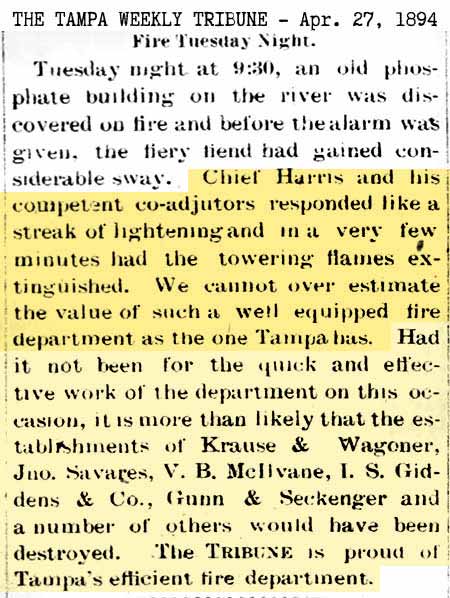
. |
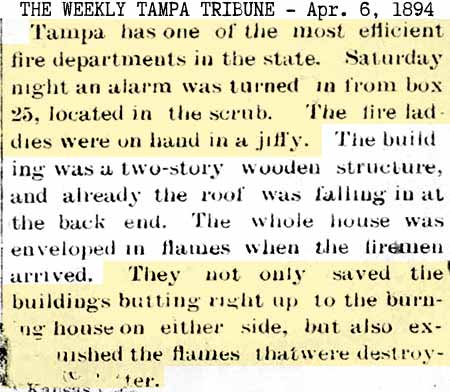
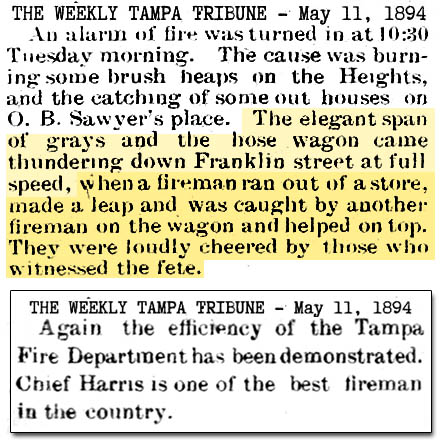 |
|
 |
On May 18, 1894, the city
council accepted the report of the Water and Fire
Protection committee recommendation to add four new fire
alarm boxes: 1) Corner of Tyler and Franklin, 2)
Division and 9th St., 3) 11th Ave. and 17th St., 4) 14th
Ave. and 20th St.
|
At
their June 29 meeting, the city council authorized
the sanitation and fire departments a loan because
they had no funds to pay their running expenses. |
In July, Chief A. J. Harris
traveled to Atlanta to convince the Association to
lower their fire insurance rates for Tampa due to
the recent improvements of fire protection. |
|
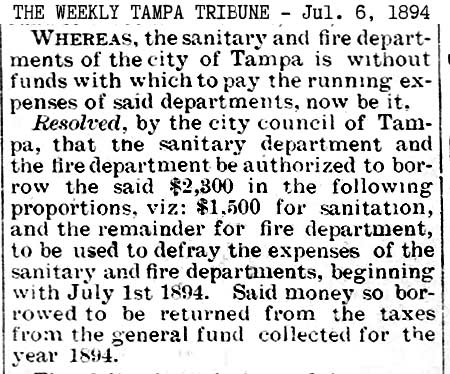 |
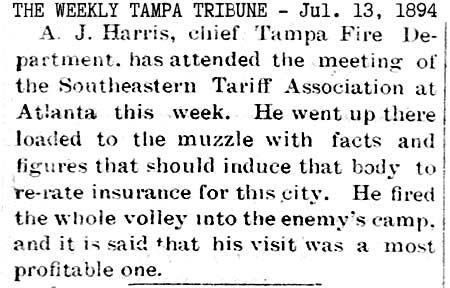 |
Catastrophic Fire at the Tampa Lumber Co., July 27, 1894

|
Below by
D. B. McKay, Aug. 23, 1959, Tampa Tribune, "Pioneer
Florida"
|
The most
spectacular fire in Tampa within my memory--before
we had a paid fire department--occurred at John B.
Spencer's livery barn. The big two-story
structure extended from Water Street to Tampa Street
on the south side of Jackson Street. Stables
for the stock were on the ground and the loft was
filled with hay, grain and vehicles.
When discovered,
the fire had a good start, but the volunteers
responded promptly to the alarm and checked the
flames before they had reached the most flammable
material. The horses, mules and valuable
Spanish jack were released and ran wild in the
streets.
The department's
equipment consisted of a hand pump operated by four
men, and the water supply was the Jackson Street
ditch, which was the full width of the street from
Morgan Street to the river, with an average depth of
25 feet. During the rainy season the ditch was
filled to street level. Robert Mugge
presented the pump to the department and other
citizens gave hose carts and hose.
At this point, McKay
goes on to describe another great fire, but comes
back to the story of the Spencer stable fire near
the end of his column. He wrote,
I was standing
near T. C. Taliaferro watching the valiant fight of
the volunteers. A portion of the roof had
been cut off to give better access to the flames.
We could see Chief Harris battling desperately to
prevent the fire from reaching the large hay
storage loft. Mr. Taliaferro realized that
Harris was in great danger and he ordered the hose
man who was near him, "Turn turn that stream on
the chief and soak him thoroughly. His
clothes are smoking!" The order was obeyed so
efficiently that the chief was knocked down and
out of danger.
Following is an
analysis of these events for the purpose of
determining when this fire occurred so that McKay's
references to the department still being on a
volunteer basis, and A.J. Harris was the chief at
the time.
When did the
Spencer livery stable extend from Water St. to Tampa
St?
Below is
seen the J.B. Spencer livery stable across an eight year
span (two more maps after the following article.) Stables on the Sanborn maps were indicated by
diagonals on the structure. As McKay stated, stated,
the fire department was a volunteer department. Spencer's
livery was located on the south side of Jackson St. and at
the time of the fire, it stretched from Water St. to Tampa
St. McKay also stated that the Mugge pumper
was in use; it arrived July
30, 1886, and A.J. Harris was Chief.
|
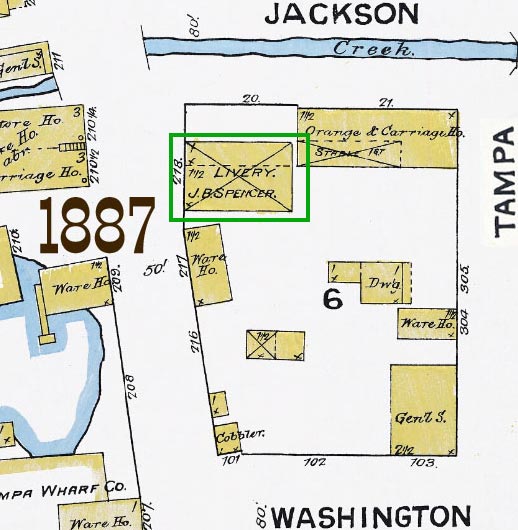 |
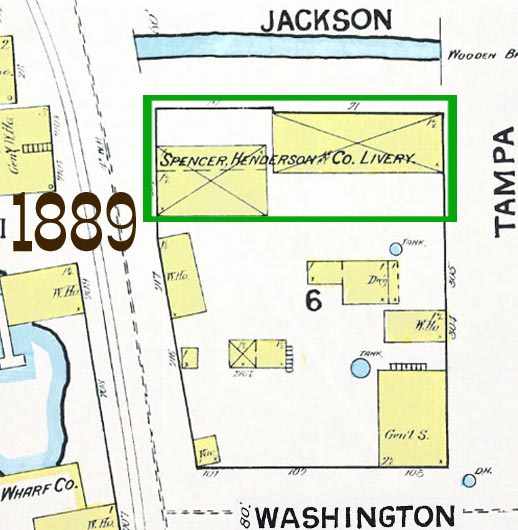 |
|
1887 - Mugge pumper in use,
department was volunteer, but here the Spencer livery
doesn't extend to Tampa St. The other building behind
it is an orange and carriage house (with a smaller stable on
the ground floor.) Both structures are 1˝ stories--a
ground floor and a loft. A.C. Wuerpel was still chief. |
1889 - not much structural change to the area, but now
Spencer has become Spencer Henderson & Co. Livery and has
taken up both structures along Jackson St. On April
17, 1889, the unorganized volunteer fire dept became
organized with the passage of city ordinance no. 40.
A.C. Wuerpel was still chief. |
| |
|
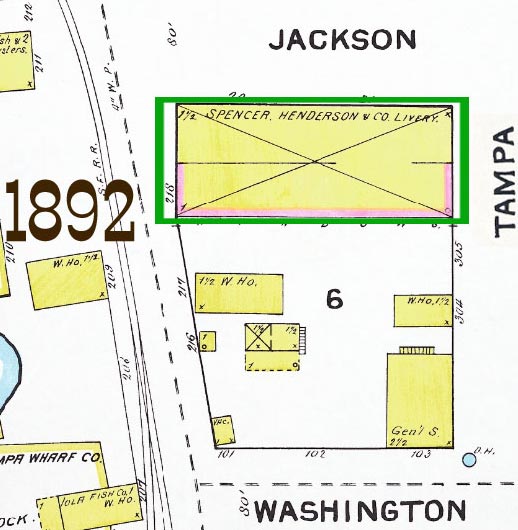 |
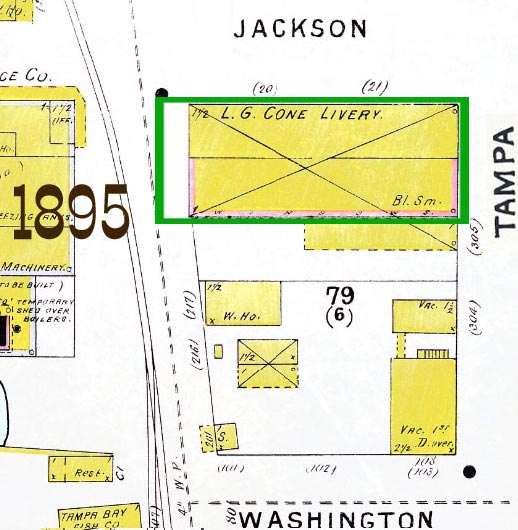 |
|
1892 - Now Spencer Henderson's livery
extends the entire block from Water to Tampa St. The
larger structure also is reinforced with a brick wall along
the south side and half of the east and west sides.
The department was still volunteer, but A.J. Harris was now
chief. |
The same structure appears in 1895, but now with an addition
on the southeast side. Now it is owned by L.G. Cone.
|
|
|
|
It is
possible this fire described by D. B. McKay occurred from mid-June, 1890 to at least 1892 and as late as 1894. |
|
The
fires emphasized the fact that Tampa's volunteer fire department and
obsolete fire fighting equipment were entirely inadequate to provide
proper protection. So a number of citizens pushed the city to
take additional action, The council was pressed to act, and
on December 31 ordered two modern La France fire engines and all
other equipment needed to establish a first-class fire department.
The engines arrived in March and were named "Manrara" and
"Salomonson," in honor of the two men who contributed money to buy
horses to pull them. On March 22, 1895, the city council
authorized the creation of a professional fire department of paid
employees.
| FIRE CHIEF ANDREW
JAMES HARRIS
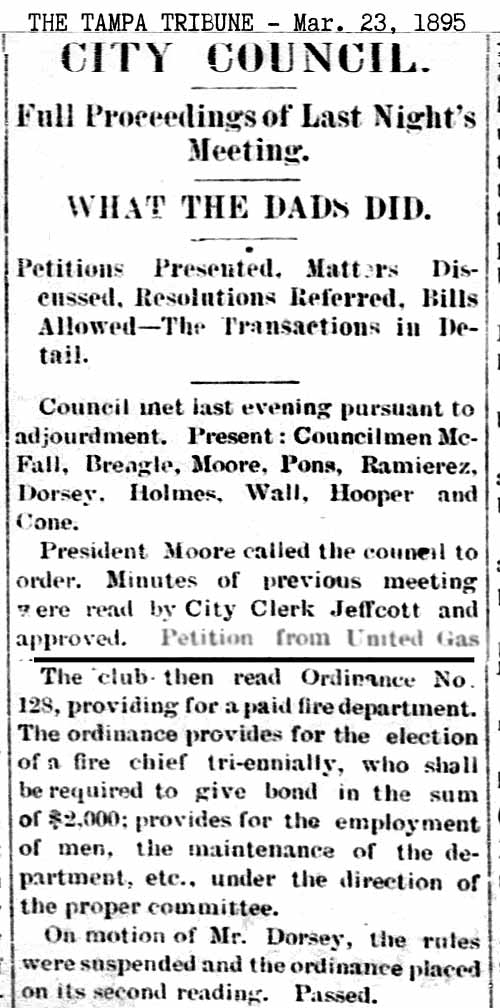 |
TAMPA'S
FIRST PROFESSIONAL, PAID FIRE DEPARTMENT On
March 22, 1895, the
city council passed ordinance #128 authorizing Tampa's first
professional, paid fire department. A. J. Harris was named chief to preside over 22 firefighters in five stations at an
annual budget of $18,000. The paid firefighters worked in the
stations for ten to twelve days at a time. Most of the firefighters
lived near their duty stations and were permitted to go home for
meals, provided they could return within one hour. Their salary was
equivalent to that of police patrol officers, about $600 a year.
By 1900 there were 5 fire stations providing protection
for the city.
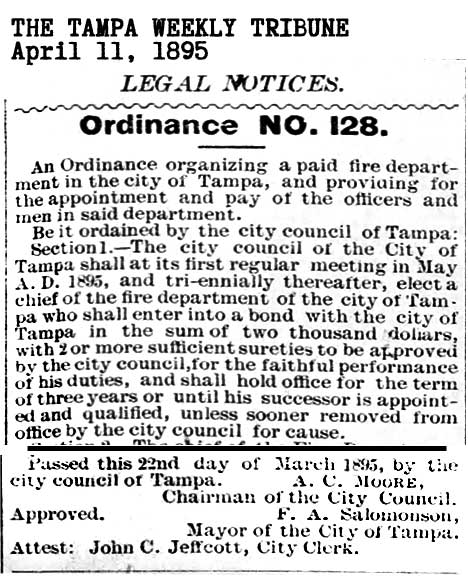 |
| |
Read
the entire Ordinance No. 128 - Seven sections long. |
(See "Tampa's
Bravest" website and history and
City of Tampa Fire-Rescue History. See for more detail)
1900 Census, Tampa, 218 Jackson St.

This census reports AJ and Mary had been married for 26 years, which
would mean Mary was around 20 and AJ was 35 when they married.
Mary's parents were born in Scotland. AJ reported that he
immigrated to the US in 1850 and was in the country for 50 years at
this point. Depending on what month he arrived, he would have
been at most, 11 or 12.
1901 George Chamberlain brutally assaulted.
Click below to see larger, then click again to see full size

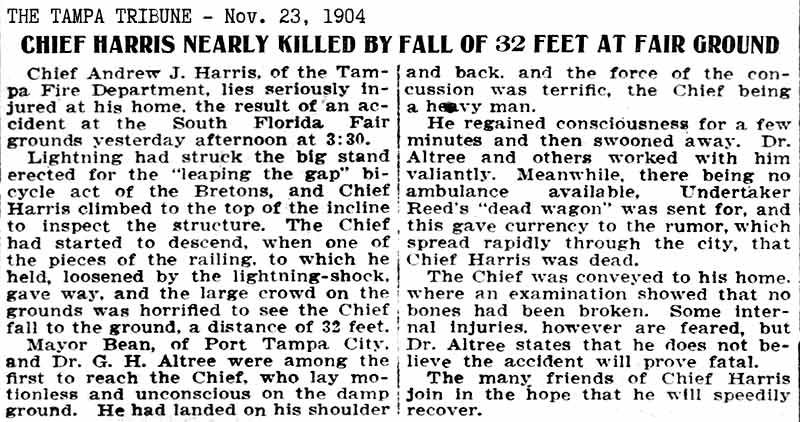
1905, May 23rd - Fire in Tampa destroys one of Robert Mugge's
buildings
A fire on May 23rd, 1905
destroyed Mugge's 2-story brick building, 60 ft x 100 ft, on the northwest corner of Franklin and Carew
streets. Mugge then brought suit in
the Circuit Court of Hillsborough County against Tampa Waterworks
for failing to provide adequate fire protection, due to low water
pressure, through a system that was supposed to be "First Class...with a reservoir capable of holding 100,000 gallons of water,
sufficient to give a pressure on the mains from a hydrant located
at the intersection of Washington and Franklin streets, and
through 100 feet of fire hose and a 1-inch nozzle, to throw a
stream of water vertically to a height or distance of 50 feet,
giving a first-class fire protection..."
The Circuit court
dismissed the suit, in favor of the Tampa Waterworks. But Mugge
took the case all the way to the Supreme Court of Florida, where
the judgment was reversed, "Error to Circuit Court, Hillsborough
County, Joseph B. Wall, Judge.
Read about the details of the case,
Mugge vs. Tampa Waterworks Co..
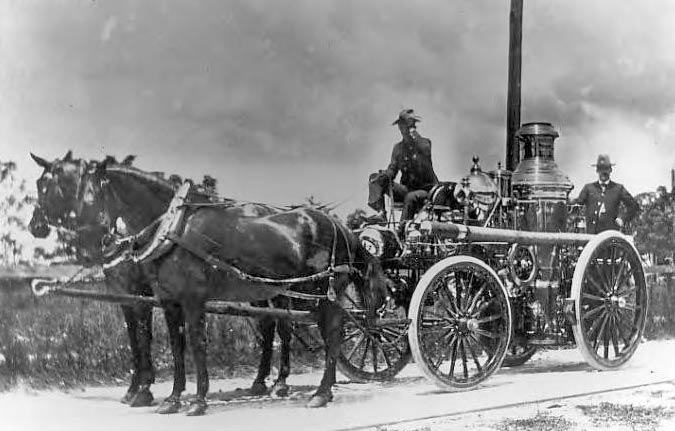 La
France horse drawn steam piston pumper, named Elmer Webb,
assigned to Station 4 of the Tampa Fire Department.
Burgert Brothers photo from the Hillsborough County
Public Library Cooperative Digital collection.
1910 Census, Tampa - 314 Florida Avenue between Lafayette & Jackson
St.

The Harrises were living in the old Stringer house next to City
Hall.
Andrew's age was a bit underreported, he was 70 years old at this
time. M1 means it was the first marriage for both AJ and Mary,
but they indicate they had been married for 27 years, only one year
longer than reported on their 1900 census. If this is correct,
Mary would have been 26 when they married, AJ would have been 36..
A. J. Harris died on June 20, 1910 at age 70,
two months after his 1910 census was taken. (He would have been 71 in late August.)
It begins:
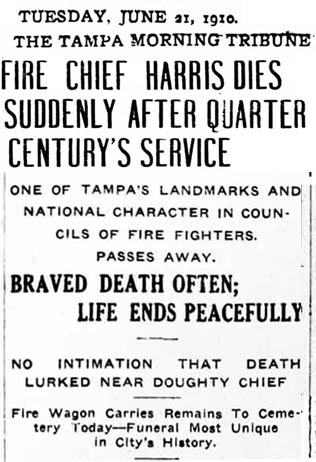 For
the past quarter of a century actively identified with the Tampa
Fire Department, its father, founder and chief, Andrew J. Harris
died suddenly at 1:50 p.m. yesterday at his office. The cause
of death is given out as acute indigestions. This covers a
ramification of ailments including angina pectoris, apoplexy and
internal hernia. It is believed that his death was caused from
either apoplexy or heart disease, he having in past years suffered
at periods with his heart. For
the past quarter of a century actively identified with the Tampa
Fire Department, its father, founder and chief, Andrew J. Harris
died suddenly at 1:50 p.m. yesterday at his office. The cause
of death is given out as acute indigestions. This covers a
ramification of ailments including angina pectoris, apoplexy and
internal hernia. It is believed that his death was caused from
either apoplexy or heart disease, he having in past years suffered
at periods with his heart.
This city was shocked at the news. Many people heard it and
were incredulous. That the fire chief should die from natural
causes came as a surprise to all since he has escaped from so many
narrow calls of tragic death in the past, the his most intimate
friends could not believe that he would meet his end in equally
tragic manner.
He
was born in Gibraltar, England, but came to the United States while
in his teens. He accompanied his step father to America.
He fought in the Confederate army during the War Between the States
and while a young man, with the late Geo. T. Chamberlain of Tampa,
served as volunteer in the Philadelphia fire department.
Read the
entire article at left, published the day after his death. It
contains many accounts of his "close calls" and heroic efforts. After opening
the article, click it again to see it full size.
Below: On the
1-year anniversary of his passing, the Tribune paid this tribute to
him via a letter received by his widow from a friend (The article is
incorrect about the date):
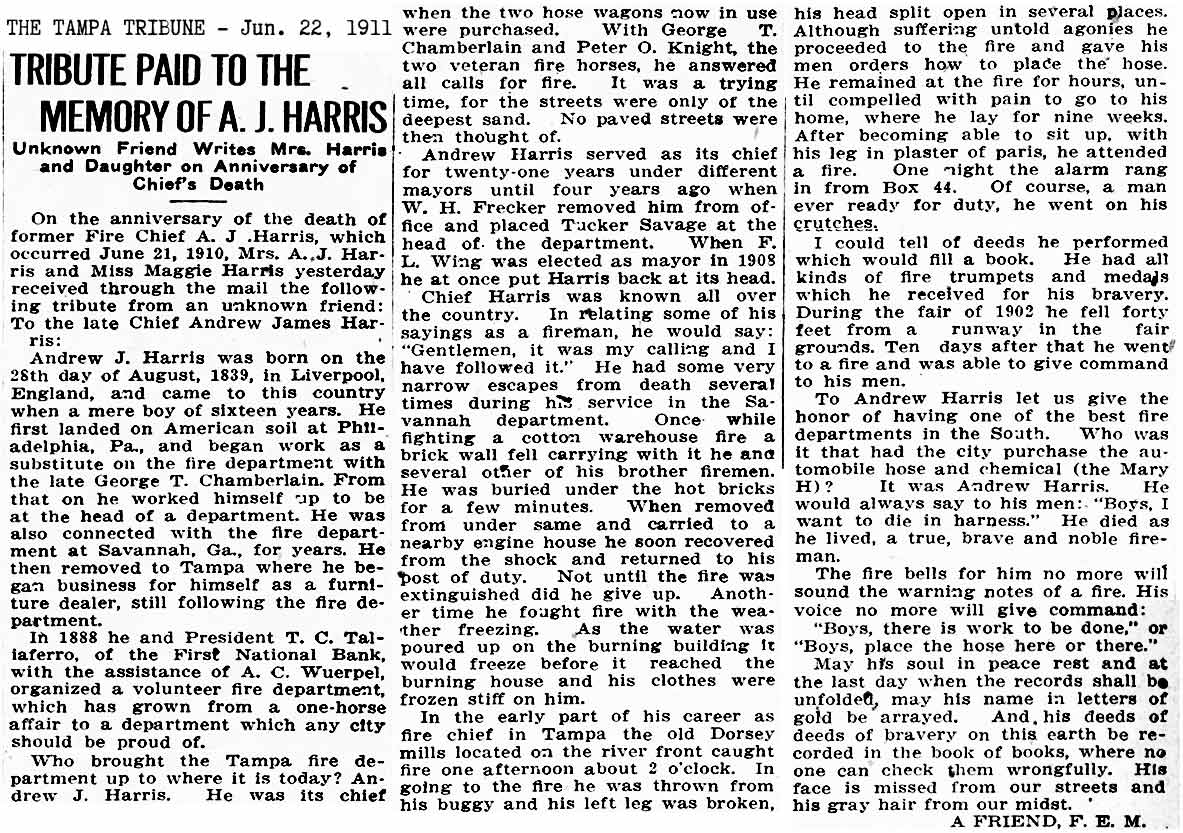
|